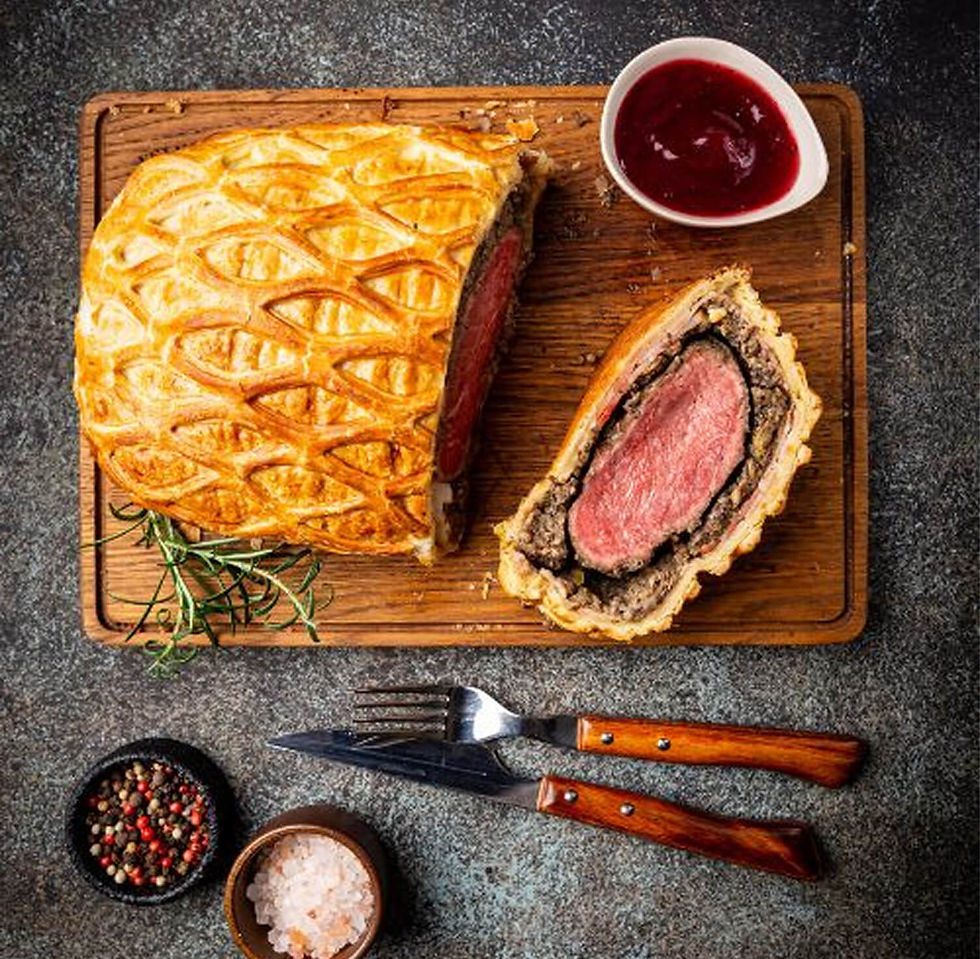Add a French Flair to Your Christmas Dinner with these Traditional French Side Dishes
- ckcallighan20209
- Dec 13, 2024
- 6 min read

I am in a dinner group that has a potluck every Christmas. We often have a theme, which makes putting the menu together a bit easier. We’ve had a Cowboy Christmas theme and also British, Mexican, and Italian themes. This year we are focusing on France.
To help with planning, I did some research on what a traditional Christmas dinner in France is like. They start with bubbly and appetizers. Sounds perfect for my dinner group. After bubbly, the French serve the main course, which normally consists of poultry (chicken, turkey, or goose), stuffing, dauphinois, and green beans amandine. After the main course, the French savor an assortment of cheeses and wine, then have their salad course. Salad is followed by the grand finale, Bûche de Noël, which we call Yule Log here in the States.
I have been making Dauphinois for years and that delicious recipe follows. We always have dauphinois at Christmas no matter what the theme. I also include a recipe for Green Beans Amandine, which my husband thinks is delicious.
I learned the French use chestnuts and prunes in their stuffing. In the spirit of staying with a French influence, I have included a stuffing recipe, which includes chestnuts and prunes. I looked at several French stuffing recipes, and my favorite contained ventréche, which is pork belly rubbed with salt, pepper, and garlic and then rolled and cured. Since ventréche is difficult to find in my neck of the woods, I substituted pancetta, not a particularly French food.
Chestnut, Prune, and Pancetta Stuffing
Serves 10 to 12
If you make this recipe, purchase already roasted and peeled chestnuts. Supermarkets used to carry a canned version, but now they come in a plastic, envelop-like container. If you can’t find already roasted and peeled chestnuts, be sure to roast and peel your chestnuts the day before you make the stuffing. It is a very time consuming process. Directions for roasting and peeling chestnuts follow the recipe. If you love prunes, add them. If not, don’t. Also, it will save time if you prep the bread cubes the day before. Pepperidge Farm® already-prepared stuffing won’t work in this recipe.
2 (14-ounce) loaves sourdough bread, cut into ⅓-inch dice, about 12 cups, or 28 ounces
⅔ pound pancetta, sliced and chopped
6 tablespoons butter
2 cups celery, chopped
2 ⅔ cups white onion, chopped
1 teaspoon salt
½ teaspoon large grind black pepper
4 teaspoons fresh sage, chopped
3 cups whole roasted and peeled chestnuts, halved
1 ⅓ cups pitted prunes, quartered, optional
3 ⅓ cups chicken broth
3 large eggs, lightly beaten
Preheat the oven to 400 degrees F. On shallow baking sheets, spread bread cubes in a single layer and toast, stirring once halfway through, until golden and dry, about 15 minutes. Transfer cubes to a large bowl.
In a large heavy skillet, sauté pancetta over a medium heat, stirring occasionally, until browned and cooked through, about 10 minutes.
Add butter to the skillet with the pancetta and melt. Add celery and onions and sauté, stirring occasionally, until celery is soft and onion is translucent, about 10 minutes. Add salt, pepper, and sage and stir to combine.
Transfer the pancetta mixture to the bowl with the bread cubes. Add chestnuts and prunes and mix thoroughly.
In a medium bowl, place chicken broth and eggs and whisk to combine. Add the chicken broth mixture to the bread cubes and mix thoroughly.
Transfer to a 12 X 17-inch baking dish. Cover with aluminum foil. Bake covered for 30 minutes. Remove the foil and bake an additional 15 minutes.
Tips on selecting chestnuts: It is difficult to select good chestnuts because it is hard to judge their inner quality by their outer shells. Your best bet is to buy chestnuts at a high-volume market that moves product quickly. Once the shells are cracked open, a good quality chestnut will be light tan in color and plump and meaty. Chestnuts with greenish mold between the nut and its outer skin or hard, darkened areas should be discarded.
Tips on storing chestnuts: Chestnuts will keep up to 1 month in the refrigerator.
Tips on removing the shell: Using a sharp paring knife, make an X on the domed side of the chestnut. Roast in an oven at 400 degrees F for 20 minutes. It is easier to remove the shells when the chestnuts are warm, so remove only a few at a time from the oven. Cool slightly and break away the shell. Remove the brown inner skin.

Dauphinois
Serves 8
1 tablespoon butter
2 pounds Yukon gold potatoes, peeled
2 cups milk
1 ½ cups heavy cream
2 teaspoons minced garlic
¾ teaspoon salt
½ teaspoon ground white pepper
4 ounces shredded Gruyere cheese, or to taste
3 tablespoons butter
Parsley, chopped, for garnish
Preheat the oven to 400 degrees F. Coat a 3-quart baking dish with 1 tablespoon butter.
Using a food processor or a mandolin, slice potatoes ⅛-inch thick and place in a large saucepan or kettle. Add milk, heavy cream, garlic, salt, and white pepper and bring to a boil over medium heat, stirring frequently to prevent scorching. Simmer gently for 5 minutes. Remove the pan from the heat. Using a slotted spoon, transfer the potato slices into the prepared baking dish, arranging the slices in an even layer. Sprinkle with half the cheese. Add the remaining potato slices on top of the cheese, again arranging in an even layer. Pour the cream mixture over the potatoes and top with the remaining cheese. Dot with the remaining 3 tablespoons butter.
Set the baking dish on a rimmed cookie sheet, place it in the oven, and bake uncovered for 30 minutes. Reduce the heat to 350 degrees F and continue baking for 30 more minutes. Potatoes are done when golden brown, or when the tip of a knife inserted in the center pierces the potatoes easily and comes out clean. Allow the dish to sit 15 minutes before serving.
Garnish with parsley if desired.
Tips on shopping for potatoes: Select firm, smooth, clean potatoes that have few eyes and good color. Potatoes should be blemish-free. Russets should have a net-like textured skin, oval shape, and brown color. Irregular-shaped potatoes produce more waste when peeling. Do not buy potatoes with wrinkled or wilted skin, sprouts, or cut surfaces. Avoid potatoes with soft, dark spots.
Tips on storing potatoes: Potatoes will keep up to 2 weeks when stored in a cool, dark, well-ventilated place. Prolonged exposure to light will turn potatoes green. Green potatoes contain solanine, which has a bitter flavor and can be toxic if eaten in large quantities. When stored at temperatures below 40 degrees F, potatoes become sweeter.

Green Beans Amandine
Serves 4 to 6
1 pound green beans, trimmed
3 tablespoons butter
¾ cup slivered or sliced almonds
1 medium shallot, thinly sliced
2 teaspoons minced garlic
1 ½ tablespoons fresh lemon juice
Salt to taste
Large grind black pepper to taste
Bring a large kettle of water to a boil over a high heat. Prepare an ice bath by filling a large bowl with cold water and ice cubes.
Add green beans to boiling water and cook until tender crisp, about 3 minutes. Transfer green beans to the ice bath and allow to cool completely. Drain and dry thoroughly.
In a large skillet, melt butter over a medium heat. Add almonds and sauté until golden, stirring frequently, about 4 minutes. Add shallot and garlic and continue sautéing, about 2 more minutes, or until shallot is soft. Add lemon juice and sauté 1 more minute.
Add green beans back to the skillet and stir to combine with the sauce. Continue cooking until beans are warmed through, about 2 to 3 minutes.
Tips on selecting green beans: Don’t just grab a handful of beans. Sort through them and select tender, crisp, well-formed beans. If freshly picked, green beans will have a smooth, velvety skin. Do not buy beans that have white mold on their tips or beans that are dried or shriveled. If the beans inside the pods are visible, the beans were overgrown.
Tips on storing green beans: When you get home from the supermarket, wash the beans before storing them in a reusable, paper, or plastic bag. This extra moisture helps them stay fresh and crisp. Beans will keep 4 to 5 days in the refrigerator.
Carol Ann

Carol Ann Kates is the award-winning author of cookbook, Secret Recipes from the Corner Market, and international Amazon best-selling and award-winning author of Grocery Shopping Secrets. She’s an expert in how to shop, select, and store produce for maximizing home cooking outcomes and minimizing time and money spent. As a former supermarket and deli operator, Carol Ann shares grocery-insider wisdom—the same expertise you used to receive when patronizing a mom-and-pop establishment. Contact her at CarolAnn@CarolAnnKates.com and explore her website, www.CarolAnnKates.com.
Copyright 2024 All Rights Reserved Carol Ann Kates
1
Searing the Beef
Sear beef fillets on high heat for 2 minutes per side to form a golden crust. Let it cool before proceeding to keep the beef tender.
1
Searing the Beef
Sear beef fillets on high heat for 2 minutes per side to form a golden crust. Let it cool before proceeding to keep the beef tender.
1
Searing the Beef
Sear beef fillets on high heat for 2 minutes per side to form a golden crust. Let it cool before proceeding to keep the beef tender.
1
Searing the Beef
Sear beef fillets on high heat for 2 minutes per side to form a golden crust. Let it cool before proceeding to keep the beef tender.
Notes



1
Season the good fresh beef fillets with salt and black pepper. Heat olive oil in a pan over high heat and sear the fillets for 2 minutes per side until it fully browned. Remove the beef from the pan and brush with a thin layer of mustard. Let it cool.



1
Season the good fresh beef fillets with salt and black pepper. Heat olive oil in a pan over high heat and sear the fillets for 2 minutes per side until it fully browned. Remove the beef from the pan and brush with a thin layer of mustard. Let it cool.



1
Season the good fresh beef fillets with salt and black pepper. Heat olive oil in a pan over high heat and sear the fillets for 2 minutes per side until it fully browned. Remove the beef from the pan and brush with a thin layer of mustard. Let it cool.



1
Season the good fresh beef fillets with salt and black pepper. Heat olive oil in a pan over high heat and sear the fillets for 2 minutes per side until it fully browned. Remove the beef from the pan and brush with a thin layer of mustard. Let it cool.
Instructions
Quality Fresh 2 beef fillets ( approximately 14 ounces each )
Quality Fresh 2 beef fillets ( approximately 14 ounces each )
Quality Fresh 2 beef fillets ( approximately 14 ounces each )
Beef Wellington

Beef Wellington
Fusion Wizard - Rooftop Eatery in Tokyo
Author Name

Beef Wellington is a luxurious dish featuring tender beef fillet coated with a flavorful mushroom duxelles and wrapped in a golden, flaky puff pastry. Perfect for special occasions, this recipe combines rich flavors and impressive presentation, making it the ultimate centerpiece for any celebration.
Servings :
4 Servings
Calories:
813 calories / Serve
Prep Time
30 mins
Prep Time
30 mins
Prep Time
30 mins
Prep Time
30 mins










Comments